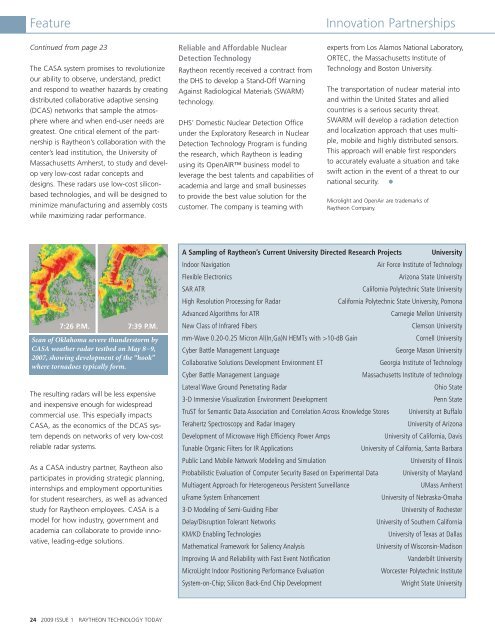2009 Issue 1 - Raytheon
2009 Issue 1 - Raytheon
2009 Issue 1 - Raytheon
Create successful ePaper yourself
Turn your PDF publications into a flip-book with our unique Google optimized e-Paper software.
Feature Innovation Partnerships<br />
Continued from page 23<br />
The CASA system promises to revolutionize<br />
our ability to observe, understand, predict<br />
and respond to weather hazards by creating<br />
distributed collaborative adaptive sensing<br />
(DCAS) networks that sample the atmosphere<br />
where and when end-user needs are<br />
greatest. One critical element of the partnership<br />
is <strong>Raytheon</strong>’s collaboration with the<br />
center’s lead institution, the University of<br />
Massachusetts Amherst, to study and develop<br />
very low-cost radar concepts and<br />
designs. These radars use low-cost siliconbased<br />
technologies, and will be designed to<br />
minimize manufacturing and assembly costs<br />
while maximizing radar performance.<br />
7:26 P.M. 7:39 P.M.<br />
Scan of Oklahoma severe thunderstorm by<br />
CASA weather radar testbed on May 8−9,<br />
2007, showing development of the “hook”<br />
where tornadoes typically form.<br />
The resulting radars will be less expensive<br />
and inexpensive enough for widespread<br />
commercial use. This especially impacts<br />
CASA, as the economics of the DCAS system<br />
depends on networks of very low-cost<br />
reliable radar systems.<br />
As a CASA industry partner, <strong>Raytheon</strong> also<br />
participates in providing strategic planning,<br />
internships and employment opportunities<br />
for student researchers, as well as advanced<br />
study for <strong>Raytheon</strong> employees. CASA is a<br />
model for how industry, government and<br />
academia can collaborate to provide innovative,<br />
leading-edge solutions.<br />
24 <strong>2009</strong> ISSUE 1 RAYTHEON TECHNOLOGY TODAY<br />
Reliable and Affordable Nuclear<br />
Detection Technology<br />
<strong>Raytheon</strong> recently received a contract from<br />
the DHS to develop a Stand-Off Warning<br />
Against Radiological Materials (SWARM)<br />
technology.<br />
DHS’ Domestic Nuclear Detection Office<br />
under the Exploratory Research in Nuclear<br />
Detection Technology Program is funding<br />
the research, which <strong>Raytheon</strong> is leading<br />
using its OpenAIR business model to<br />
leverage the best talents and capabilities of<br />
academia and large and small businesses<br />
to provide the best value solution for the<br />
customer. The company is teaming with<br />
experts from Los Alamos National Laboratory,<br />
ORTEC, the Massachusetts Institute of<br />
Technology and Boston University.<br />
The transportation of nuclear material into<br />
and within the United States and allied<br />
countries is a serious security threat.<br />
SWARM will develop a radiation detection<br />
and localization approach that uses multiple,<br />
mobile and highly distributed sensors.<br />
This approach will enable first responders<br />
to accurately evaluate a situation and take<br />
swift action in the event of a threat to our<br />
national security.<br />
Microlight and OpenAir are trademarks of<br />
<strong>Raytheon</strong> Company.<br />
A Sampling of <strong>Raytheon</strong>’s Current University Directed Research Projects University<br />
Indoor Navigation Air Force Institute of Technology<br />
Flexible Electronics Arizona State University<br />
SAR ATR California Polytechnic State University<br />
High Resolution Processing for Radar California Polytechnic State University, Pomona<br />
Advanced Algorithms for ATR Carnegie Mellon University<br />
New Class of Infrared Fibers Clemson University<br />
mm-Wave 0.20-0.25 Micron Al(In,Ga)N HEMTs with >10-dB Gain Cornell University<br />
Cyber Battle Management Language George Mason University<br />
Collaborative Solutions Development Environment ET Georgia Institute of Technology<br />
Cyber Battle Management Language Massachusetts Institute of technology<br />
Lateral Wave Ground Penetrating Radar Ohio State<br />
3-D Immersive Visualization Environment Development Penn State<br />
TruST for Semantic Data Association and Correlation Across Knowledge Stores University at Buffalo<br />
Terahertz Spectroscopy and Radar Imagery University of Arizona<br />
Development of Microwave High Efficiency Power Amps University of California, Davis<br />
Tunable Organic Filters for IR Applications University of California, Santa Barbara<br />
Public Land Mobile Network Modeling and Simulation University of Illinois<br />
Probabilistic Evaluation of Computer Security Based on Experimental Data University of Maryland<br />
Multiagent Approach for Heterogeneous Persistent Surveillance UMass Amherst<br />
uFrame System Enhancement University of Nebraska-Omaha<br />
3-D Modeling of Semi-Guiding Fiber University of Rochester<br />
Delay/Disruption Tolerant Networks University of Southern California<br />
KM/KD Enabling Technologies University of Texas at Dallas<br />
Mathematical Framework for Saliency Analysis University of Wisconsin-Madison<br />
Improving IA and Reliability with Fast Event Notification Vanderbilt University<br />
MicroLight Indoor Positioning Performance Evaluation Worcester Polytechnic Institute<br />
System-on-Chip; Silicon Back-End Chip Development Wright State University

















